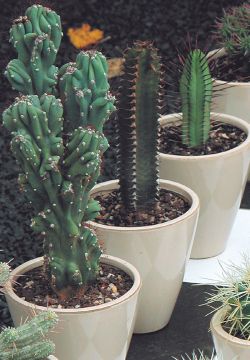Plant
Doctor Archive
Cracked
cacti
  I
LOVE and collect cacti. One of my cacti has been getting dry, cracked
rotten bits around the base of the spines. What is this and is there
a cure? I
LOVE and collect cacti. One of my cacti has been getting dry, cracked
rotten bits around the base of the spines. What is this and is there
a cure?
 I
CHECKED with the experts at Coromandel Cacti and we've decided that
your plant is suffering from some sort of stress. Under extreme
stress, cacti sometimes convert normally green tissue into a dry,
woody bark-like substance, which often looks diseased. I
CHECKED with the experts at Coromandel Cacti and we've decided that
your plant is suffering from some sort of stress. Under extreme
stress, cacti sometimes convert normally green tissue into a dry,
woody bark-like substance, which often looks diseased.
Stress could be caused
by the plant being pot bound, suffering root pests or diseases or
a combination of these. Although the damaged areas won't recover,
you can give the plant a new lease of life by repotting it. If it
has dead roots, trim them off - in severe cases you may have to
remove the whole root system and perhaps even cut into the base
of the stem to remove rotten tissue. If you do trim the roots, leave
the plant in a warm dry place for several days so the wounds properly
dry off and new tissue starts to grow.
Cut stems need to dry
for longer and the bigger the cut the longer they take - it pays
to leave plants with large wounds for weeks before repotting. Use
a specialist cacti mix and remember that although cacti can stand
long periods of drought, most varieties grow better with regular
watering.
Mealybugs can attack
the roots of some cacti. These small, white, woolly-looking bugs
could be contributing to your plant's condition. You can control
them with an insecticide such as Carbaryl or Malathion. Thoroughly
soak the whole root system with it (leave the roots to dry before
repotting). Or leave the plant in its pot and water the solution
into the mix. Follow the label's safety recommendations while doing
this and dispose of any left over spray safely - the best way is
to pour it on soil in an unused part of your garden, not down a
drain.
Weekend
Gardener, Issue 130, 2003, Page 26
Reproduced with permission from the former Weekend Gardener magazine. The views expressed here are not necessarily those of the RNZIH.
|
 |
 |
|